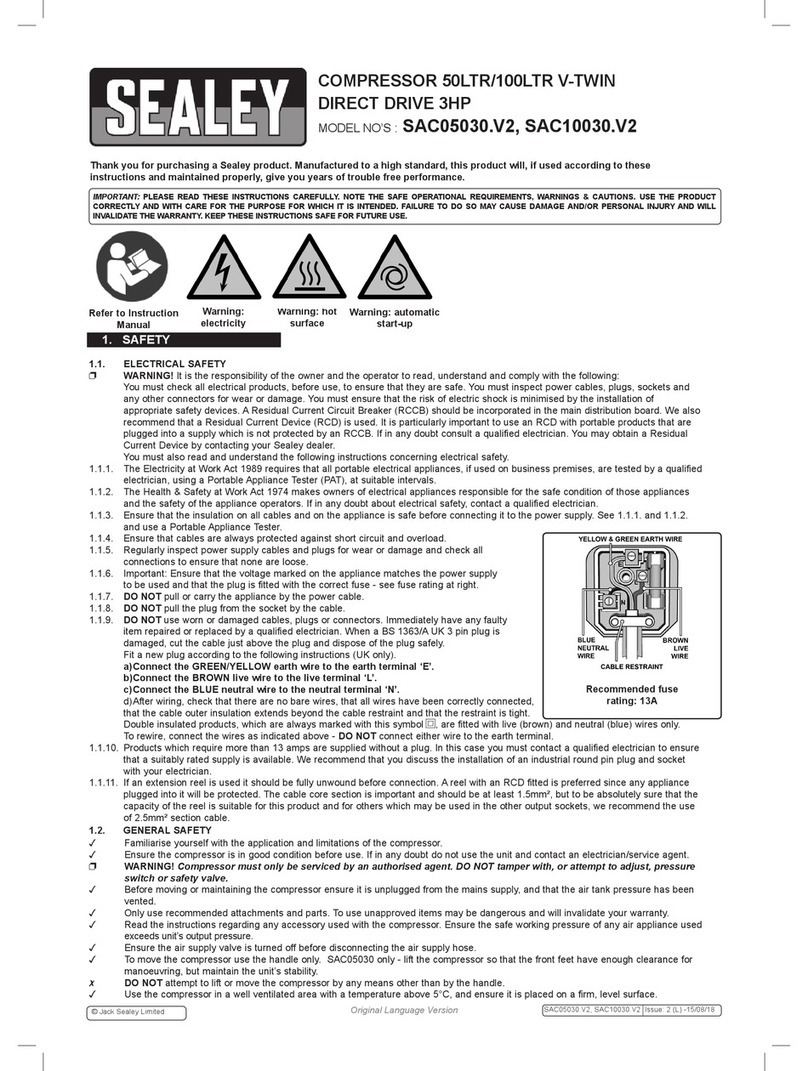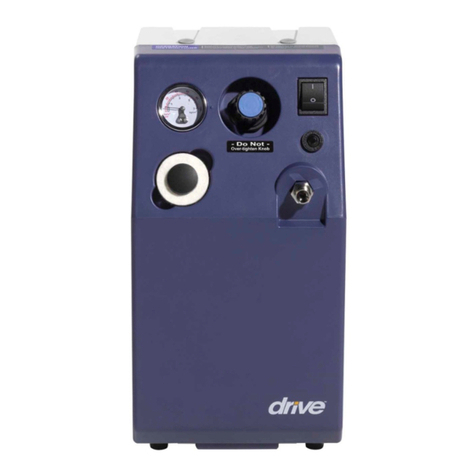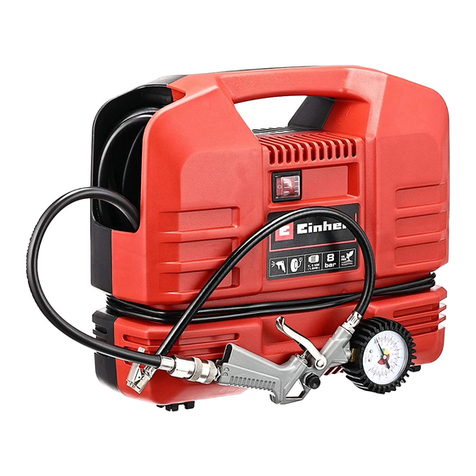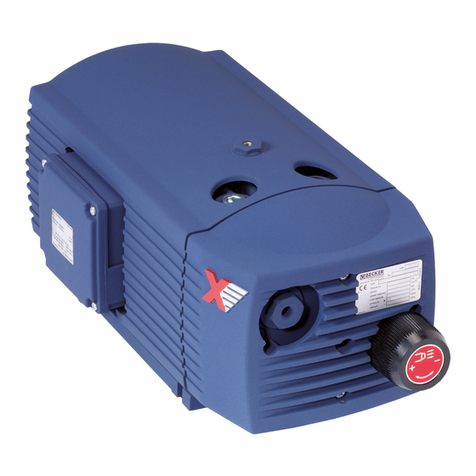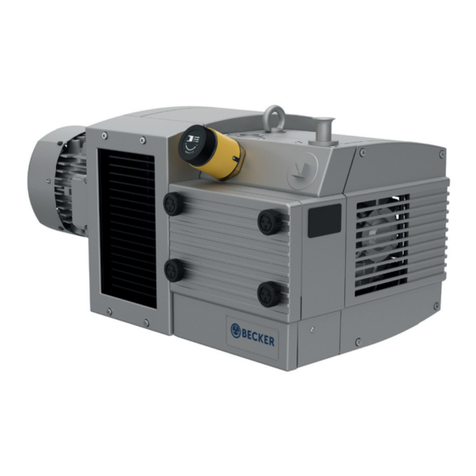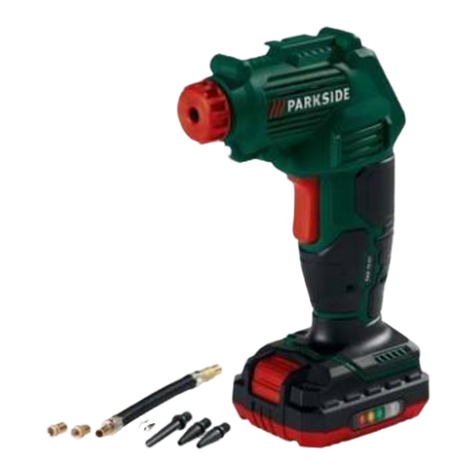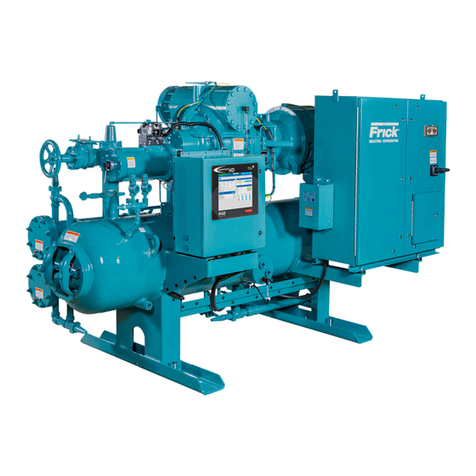Teledyne 5800 User manual

5800 Refrigerator Compressor
Capacitor/Relay Kit
Instruction Sheet
Overview
The refrigerator compressor relay and capacitor are
components of the Teledyne Isco 4700 and 5800
refriger-ated samplers. These instructions cover their
removal and replacement in both models.
Section one of this instruction sheet describes how
to access the refrigeration components. You must then
determine which voltage rating and type of startup relay
and capacitor you are replacing. Section two provides
instructions appropriate for your refrigerator.Section
three re-installs the refrigeration module, and section
four tests operation following the installation.
Before attempting to remove and replace a module,
observe the following precautions:
WARNING
Removing a module exposes you to electrical and
mechanical hazards. Always disconnect the AC
power cord before attempting to remove any
module. Only trained service personnel may
remove or replace these modules.
CAUTION
Removing the sealed modules will expose the internal
components. Wet or corrosive atmospheres may attack
the exposed refrigerator components. Always service
modules in a dry, corrosion-free environment.
CAUTION
Modules contain circuit boards and sensitive electronics
that can be damaged by a discharge of static electricity.
Avoid touching the internal components. Only handle
the module by the edges or exterior surfaces.
CAUTION
Electrical connectors and wires can be damaged if
improperly handled. Electrical connectors must only be
handled by the connector body. Never grasp the wires
or use tools to disconnect a connector. Never allow a
module to hang by its wiring.
CAUTION
Earth ground bonding conductor. Do not
remove or disconnect. If this conductor must
be disconnected to remove a module, it must
be reconnected when installing the
replacement module.
Required Parts and Tools
●Replacement cap & relay kit:
❍60-4707-002 for 115 VAC samplers, or
❍60-4707-004 for 230 VAC samplers
❍Nylon cable tie 489-0110-00 (For best results,
soak in water for one hour prior to use.)
●#2 & #3 Phillips screwdrivers
●5/16" socket wrench
●1/4" ratchet driver
●Wire cutters
1. Accessing the Refrigeration
Components
1. Unplug the line cord to remove AC power.
2. Remove the parts according to the version of
refrigerator you have (Figure 1).
Figure 1: Remove back cover and insulation
Cover
brace
Back
cover
Insulation
panel
Refrigeration
module
Refrigeration module
Foam insulation panel
Back cover
Coil shield
Old version
New version
60-4702-009
Revision D, June 11, 2020

2
60-4702-009 Revision D, June11, 2020
Figure 2: Cut cable tie to free line cord
4. Remove the refrigeration module mounting
screws (Figure 3).
Note that older refrigeration modules have an
adhesive strip just above the rear coils. The bot-
tom center screw may be slightly hidden by this
strip.
5. Carefully pull the module out and rotate clock-
wise to expose the wiring connectors.
The bushing holding the AC line cord in place
should slide along the cord (see below). During
reinstallation, the slack created in this step must
be removed.
CAUTION
Keep the module as close to the refrigerator body as
possible to avoid pulling the wiring taut and damaging
the connectors.
Figure 3: Removing the refrigeration module
6. Determine the operating voltage—115 or 230 VAC.
This can be read from the serial num-ber label
located inside the refrigerated bottle compartment.
Proceed with instructions 2A for 115 VAC models,
or 2B for 230 VAC models to replace the startup
capacitor/relay assembly.
2A. 115 VAC Models - Replacing the
One-piece Capacitor/Relay
1. Remove the cover from the compressor terminal
box. If needed, use a screwdriver to release the
locking tab.
2. Unplug the white connector with the orange and
black wires from the bottom 2 pins on the com-
pressor (Figure 6). On newer models this con-
nector will be black and the wires will be orange
and white. The orange wire always goes to the
left.
3. Disconnect the blue wire from the capacitor/
relay assembly from the blue wire from the
power supply (Figure 6). On newer power sup-
plies the power supply wire will be gray.
4. Disconnect the black wire from the capacitor/
relay assembly from the ribbed black fan wire.On
newer refrigerators the second black wire from
the cap and relay assembly goes to the wrap
around heater on the compressor.Ifthe com-
pressor has no heater then second black wire is
not used. Tape the wireoff and tuck away.
5. Remove the capacitor/relay assembly.
A 5/16-inch socket, short extension, and a 1/4-inch
ratchet driver are recommended to loosen the
lock nuts. Once loose, lift the assembly to
remove it (Figure 4).
Figure 4: Attach the adapter plate
6.Mount the new assembly on the same posts
which held the old assembly. Tighten the lock
nuts with a 5/16-inch socket wrench to secure
the new assembly (Figure 5).
Cut cable tie
Adhesive
strip
Turn module out
and left
Line cord
bushing
3. Cut the cable tie holding the power cord that
runs through the refrigeration assembly
(Figure 2).

3
60-4702-009 Revision D, June11, 2020
Figure 5: Mount the new assembly
Refer to Figure 6 for steps 7through 9.
Figure 6: 115 VAC wiring connections
Plug the black connector from the new assembly
onto the compressor pins below the terminals. Be
sure the black connector is oriented so the orange
wire is on the left side (Figure 6).
Connect the black wire from the capacitor/relay
assembly to the ribbed black fan wire. On newer
refrigerators the second black wire from the cap
and relay assembly goes to the wrap around heater
on the compressor.Ifthe compressor has no heater
then the second black wire is not used. Tape the
wireoff and tuck away.
Connect the blue wire from the capacitor/relay
assembly to the blue wire from the power supply.
On newer power supplies the power supply wire
will be gray. (Figure 6)
Route all wire connections inside the compressor
terminal box and replace the cover.
Note
If you have a unit with serial number 216B or older,
skip to section 3A. Module Replacement- Serial
Number 216B and Older using the instructions on
page 4.
2B. 230 VAC Models - Replacing the
One-piece Capacitor/Relay
1. Remove the cover from the compressor terminal
box. If needed, use a screwdriver to release the
locking tab.
2. Unplug the white connector with the orange and
black wires from the bottom 2 pins on the com-
pressor.On newer models this connector will be
black and the wires will be orange and white; the
orange always goes to the left (Figure 7).
3. Disconnect the blue wire from the capacitor/
relay assembly from the blue wire from the
power supply (Figure 7). The new power supply
will have a gray wire.
4. Disconnect the black wire from the capacitor/
relay assembly from the ribbed black fan wire.
On newer refrigerators the second black wire
from the cap and relay assembly goes to the
wrap around heater on the compressor.Ifthe
compressor has no heater then second black
wire is not used. Tape the wire off and tuck away.
5. At the right side of the compressor terminals,
loosen the top and middle wire retainers, so that
wires can easily beremoved.
6. Remove the capacitor/relay assembly.
A 5/16-inch socket, short extension, and a 1/4-inch
ratchet driver are recommended to loosen the
lock nuts. Once loose, lift the assembly to
remove it (Figure 4).
7. Attach the metal adapter plate to the new capac-
itor/relay assembly using the #6 screws and lock
nuts.
Refer to Figure 7 for steps 9 through 11.
Plug the black connector from the new assembly
onto the compressor pins below the terminals.
Note that the black connector must be oriented
so that the orange wire is on the left side.
Connect the black wire from the capacitor/relay
assembly to the ribbed black fan wire. On newer
refrigerators the second black wire from the
cap and relay assembly goes to the wrap
around heater on the compressor.If the
compressor has no heater then the second black
wireisnot used. Tape the wire off and tuck
away.
Connect the blue wire from the capacitor/relay
assembly to the blue wire from the power
supply (Figure 7). On newer power supplies the
blue wire from the power supply will be gray.
Route the wires, align and tighten the retainers
(Figure 8).
white connector
(orange on left)
ribbed black
black
blue
blue
7.
8.
9.
10.
8.
9.
10.
11.

4
60-4702-009 Revision D, June11, 2020
Figure 7: 230 VAC new wiring connections
Figure 8: 230 VAC route and secure wires
(side view of compressor terminals)
Route all wire connections inside the compressor
terminal box and replace the cover.
Note
If you have a unit with serial number 216B or greater,
skip to section 3B. Module Replacement-Serial
Number 216B and Newer.
3A. Module Replacement - Serial
Number 216B and Older
The refrigeration module and rear compartment of
the cabinet have adhesive strips and Permagum1
(caulking cord sealant) protecting the components
(Figures 9 and 10). Ensure that all adhesive strips and
Permagum are still in place before reassembly.
The adhesive strips and Permagum are required to
prevent air flow between the condenser coil and the
evaporator plate. Without this protection, water con-
densation on the coil will cause ice build-up, resulting in
poor refrigerator performance.
Note
Two thick, black cables connect the power supply with
the AC and compressor (see Figure 9). Ensure that
these cables are side by side and not crossed
during reassembly.
Figure 9: Rear view with module removed
(Adhesive strips, Permagum sealant, power cables)
Figure 10: Rear view of refrigeration module
(Adhesive strip, Permagum sealant)
1. Move the refrigeration module up to the rear of
the refrigerator and replace the drain tube in
the drip pan on the module.
1. Permagum is a registered trademark of the Presstite Engineering Company.
white connector
(orange on left)
ribbed
black
black
blue
blue
Top Slot Wires:
• ribbed and smooth
fan wires
Middle Slot Wires:
• single blue
• orange
• black (x2)
• single green/yellow
Power supply cables Adhesive strips
Permagum
sealant
Permagum
sealant
Adhesive
strip
Center
screw
12.

5
60-4702-009 Revision D, June11, 2020
Figure 11: Position drain tube
in front half of drip pan.
2. Reinstall the refrigeration module, tipping the
top back while sliding the bottom forward. When
the bottom is in place, push the top into place.
Figure 12: Slide refrigeration module into place
CAUTION
When reinstalling all self-tapping screws, avoid
destroying the plastic threads. First seat each screw in
its hole and, without pressing down, rotate the screw
counter-clockwise until it falls into its thread groove with
a "click." Then tighten the screw.
3. Reinstall the refrigeration module mounting
screws (8), insulation panel/back cover screws
(5), and cover brace screws (2).
Figure 13: Old version
CAUTION
When installing/replacing the refrigeration unit, the line
cord MUST be properly secured. This is to ensure that
the cord cannot be pushed into the enclosure and be
caught in the fan.
4. Hold the line cord taut to remove any slack, and
attach a cable tie 489-0110-00, as shown below.
Figure 14: Attach cable tie to line cord
5. Restore AC power to the refrigerator.
6. After 45 minutes, perform the refrigerator
temperature diagnostic test, as described in
the section 4. Refrigerator Temperature Diag-
nostic at the end of this document.
Push top in
second.
Push
bottom in
first.
Cover
brace
Back
cover
Insulation
panel
Refrigeration
module
Attach cable tie

6
60-4702-009 Revision D, June11, 2020
3B. Module Replacement-Serial Number
216B and Newer
Complete the following to reinstall the refrigerator
module:
1. Ensure that the control wiring runs through the
channel in the refrigerator body.
Note
Two thick, black cables connect the power supply with
the AC and compressor (Figure 15). Ensure that
cables are side by side and not crossed during
reassembly.
Figure 15: Rear view with the module removed
2. Slide the refrigeration module to the rear of the
refrigerator and place the drain tube in the drip
pan on the module (Figure 16).
Figure 16: Position drain tube
in front half of the drip
pan
3. Ensure the black gasket is aligned and gasket
nubs are inserted in corresponding holes on the
frame of the refrigerator module (Figure 17).
Figure 17: Position gasket on refrigeration module
frame
and ensure each gasket nub is inserted in
corresponding hole
CAUTION
When reinstalling the refrigeration module, do not pinch
the sensor wiring.
4. Install the module, tipping the top back while
sliding the bottom forward. When the bottom of
the system is in place, push the top into place
(Figure ). Ensure the slack in the power cord is
removed before securing refrigeration module
frame.
Figure 18: Slide module into place
CAUTION
When reinstalling all self-tapping screws, avoid
destroying the plastic threads. First seat each screw in
its hole and, without pressing down, rotate the screw
counter-clockwise until it falls into its thread groove with
a “click.” Then tighten the screw.
5. Reinstall the coil shield, back cover, and insula-
tion panel (Figure 19). When installing the foam
insulation panel, take precautions not to damage
the foam around the tubing (see inset Figure 19).
Gasket
Nub
Push top in
second.
Push bottom
in first.

60-4702-009 Revision D, June11, 2020
Teledyne ISCO
P.O. Box 82531, Lincoln, Nebraska, 68501 USA
Toll-free: (800) 775-2965 • Phone: (402) 464-0231 • Fax: (402) 465-3001
E-mail: [email protected]
Teledyne I
SCO
is continually improving its products and reserves the right to change
product specifications, replacement parts, schematics, and instructions without notice.
Figure 19: Back cover and insulation panel
6. Reinstall the refrigeration module mounting
screws (8), insulation panel/back cover screws
(5), and cover brace screws (2).
CAUTION
When installing/replacing the refrigeration unit, the line
cord MUST be properly secured. This is to ensure that
the cord cannot be pushed into the encloser and be
caught in the fan.
7. Hold the line cord taut to remove any slack,
attache the cable tie (489-0110-00) as shown in
Figure 20).
Figure 20: Attach cable tie to line cord
8. After 45 minutes, perform the refrigerator
temperature diagnostic test, as described in
the following section.
4. Refrigerator Temperature Diagnostic
The REFRIG TEMPERATURE diagnostic displays the
temperature of the refrigerated compartment.
To start the diagnostics from the standby screen:
1. Select the CONFIGURE option and press ENTER.
2. Press the left arrow button until the RUN
DIAGNOSTICS option is displayed. Press ENTER.
3. Press the right arrow key 7 times to display
REFRIG TEMPERATURE. Press ENTER to start the test.
When this test is started, the sampler should display
the temperature until you press the STOP or ENTER
button. There is no pass or fail. This test simply
provides continuous temperature monitoring.
As the refrigerator cycles off and on, the reported
temperature will rise above and below the set
temperature. However, the average reported
temperature should be the same as the configured
temperature. The evaporator temperature may at times
read as low as –20° C; this is considered normal.
If the screen displays an asterisk (*) or inaccurate
temperature reading, the temperature sensor cable may
be malfunctioning.
Refrigeration module
Foam insulation panel
Back cover
Coil shield
Foam insulation panel
Attach cable tie
PROGRAM CONFIGURE
VIEW LOG
SELECT OPTION: (<-->)
RUN DIAGNOSTICS
SELECT DIAG: (<-->)
TEST 'RAM'
SELECT DIAG: (<-->)
REFRIG TEMPERATURE
REFRIG TEMPERATURE:
AIR=__C EVAP=__C
Other manuals for 5800
4
Popular Compressor manuals by other brands

Chicago Pneumatic
Chicago Pneumatic CPF 270 Instruction book
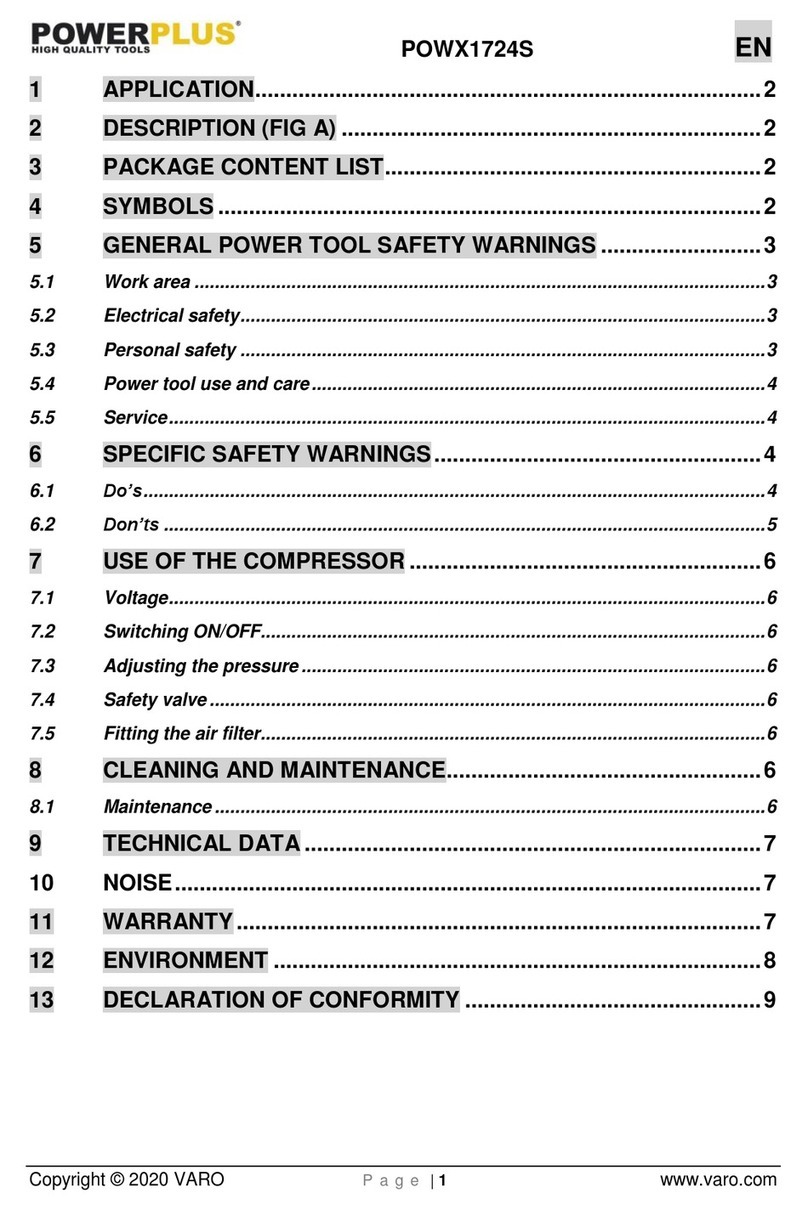
Powerplus
Powerplus POWX1724S manual
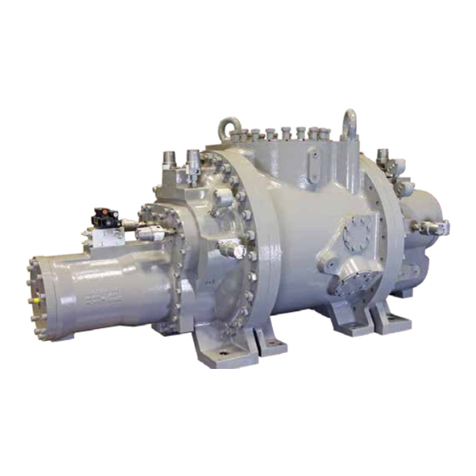
Frick
Frick SBTP 4013 Installation operation & maintenance

Panasonic
Panasonic Matsushita S51C90JAU6 Specification sheet
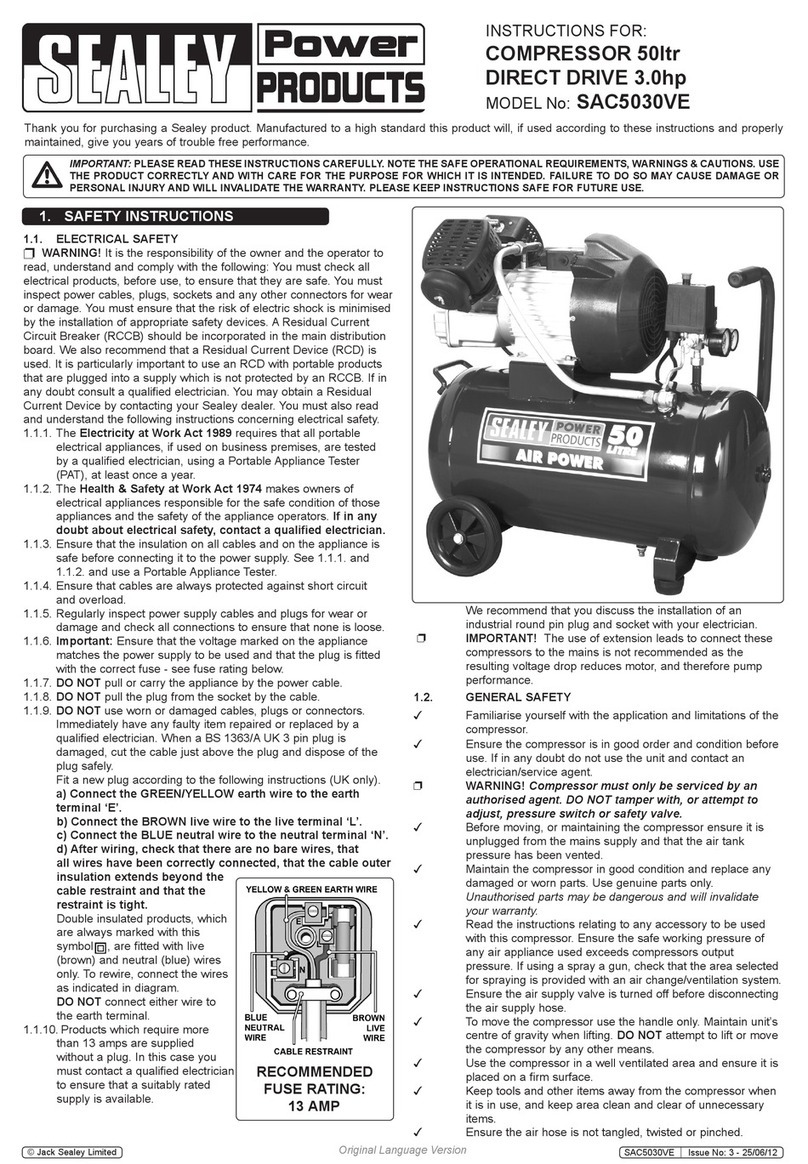
Sealey
Sealey SAC5030VE instructions

LA Audio Electronic
LA Audio Electronic C400 Operation manual
